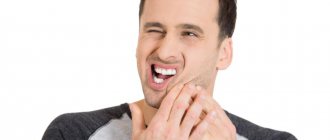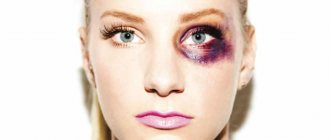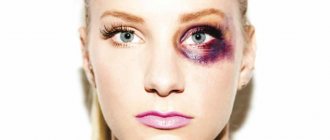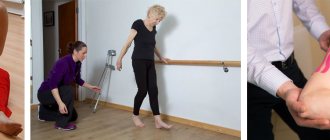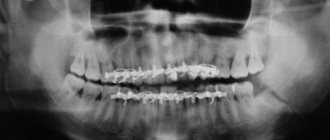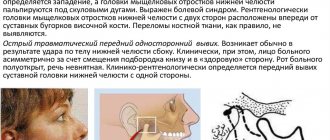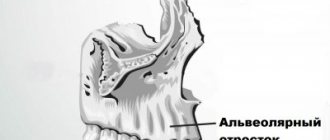Facial injuries are quite common. A jaw bruise is an injury without violating the integrity of the skin and bone tissue.
The main difference between it and a fracture is that the victim is able to close and open his mouth, although this causes serious pain. Only an experienced specialist can identify the problem and carry out differential diagnostics.
Most often, such injuries have a favorable prognosis, but it is necessary to undergo a comprehensive study to exclude possible complications. In addition, you should strictly follow medical recommendations and appear in a timely manner for preventive examinations if necessary.
Pain is the main symptom of injury
Causes of bruises in the maxillofacial area
Most injuries occur unexpectedly and to varying degrees of severity.
Most often they are observed in the following cases:
- falling onto a hard surface;
- due to collision with objects;
- various impacts (road traffic accidents, domestic fights, contact sports).
Falls are the most common causes of injuries to the maxillofacial area
The severity of such injuries largely depends on the affected area, the type of object that affected the bone tissue and age-related changes in facial tissue.
Damage to the lower jaw
This injury is the most common. It occurs in both children, adults and the elderly. The important point is to identify the type of damage as soon as possible and provide first aid. The further prognosis and duration of treatment will depend on this.
A mandibular contusion is a soft tissue injury in the lower parts of the face. As a result, an internal hematoma is formed due to the rupture of small blood vessels.
In the event of a bruise, the bone tissue remains intact and the teeth and gums are not injured. Usually occurs as a result of impact on the maxillofacial area with a blunt object.
Bruise of the jaw after a blow to the lower parts of the face on the left side
The severity of the injury is largely influenced by the moment of impact. Severe consequences are observed with highly tense muscles. In this case, they rupture, forming an extensive hematoma with a pronounced pain reaction.
Main symptoms
Any disease has its own fundamental signs. Symptoms of a bruise of the lower jaw are usually quite striking. The main sign is sharp pain, abrasions, damage to the cheek or lip.
If the blow falls on the area of the dental arch, then gaping wounds form on the soft tissues on the side of the oral cavity. The lower lip looks swollen, sagging and hyperemic.
To make a correct diagnosis, differential diagnosis is necessary. It is important to exclude fractures of the bone areas of the jaw, eye socket and nose.
After a strong blow, the victim should not be left unattended. It is imperative to monitor his general condition. Together with complaints and external examination, a preliminary diagnosis can be established.
In addition to local signs, general manifestations should also be taken into account:
- damage in the form of scratches and hyperemia in the jaw area;
- swelling in the lower part of the face;
- the presence or absence of hematoma of varying volume;
- malaise and swollen lymph nodes;
- sharp or constant pain even at rest;
- impairment in mouth opening, eating and speaking;
- increased pain response from touching the damaged area, as well as movement of the jaw to the left or right side.
Attention!!! The main differential diagnostic sign of a bruise from a fracture is that the jaw bones do not change their anatomical structure. In addition, the line of bone integrity violation can be determined by palpation.
If the injury is severe, the victim must in any case be taken to a doctor for examination to clarify the condition. It is important to carry out rapid transportation with preliminary first aid.
We divide all dental injuries of children
- Bruise - characterized by only minor damage, a crack in the enamel, hemorrhages in the pulp chamber, swelling, or bruising on the gums may be observed.
- Subluxation - a damaged tooth is displaced, its ligamentous apparatus and neurovascular bundle are partially damaged, and tooth mobility is noted.
- Luxation - incomplete and complete - the tooth protrudes significantly from the dentition, barely maintaining connection with the socket, or even falls out of it. The integrity of the neurovascular bundle and ligamentous apparatus of the tooth is compromised.
- Fracture of the crown of the tooth.
- Tooth root fracture
Further in the article we will tell you how acute injury to baby teeth in children is characterized by an impact, how to recognize an injury to the front teeth, and how to treat any tooth injury in a child.
Damage to the upper jaw
The nature of injury in this area is more complex. Its danger lies in the fact that serious complications may occur. It is quite easy to distinguish a bruise of the upper jaw from the lower one.
This is determined by the location of the pain and the consequences of trauma. However, it should be taken into account that unpleasant sensations can radiate to the lower part of the face. But the main difference here will be the absence of impaired mobility of the lower jaw.
The symptoms of a bruise of the upper bone tissues are very similar to the previous problem. There is an inflammatory process and pain, swelling, and sometimes enlargement of regional lymph nodes. Even if there are no obvious signs of bruises, you need to go to the clinic.
The photo shows fractures of the upper jaw with severe bruises
The doctor must first rule out a fracture. In the upper jaw, such injuries are dangerous for brain damage.
For example, a Le Fort 3 fracture is a separation of the bones of the skull and face. Without professional medical care, death can occur in this case.
International standards
A real revolution in maxillofacial surgery occurred in 1958, when M. Muller, M. Allgower, R. Schneider, H. Willenegger organized the International Association for the Study of Internal Fixation (AO/ASIF - Ardeitsgemeinschaft fur Osteosynthesefragen/Association for the Study of Internal Fixation – working association for the study of osteosynthesis/association for the study of internal fixation).
According to the postulates of AO/ASIF, the osteosynthesis technique implies that:
1. the structures used must be made of bioinert metal alloys;
2. bone fragments must be anatomically accurately compared and fixed;
3. the use of gentle surgical techniques ensures the preservation of blood supply to bone fragments and surrounding soft tissues;
4. stable fixation of fragments is ensured by interfragmentary compression;
5. early application of functional load is indicated;
6. restoration of contractile activity of muscles and movement in the joint.
AO/ASIF staff also developed and implemented metal plate systems for mandibular osteosynthesis:
· dynamic compression plates;
· reconstructive (blocking) plates (Locking reconstruction plates);
· blocking (locking) plates (Locking plates 2.0 mm);
· universal plates (Universal fracture plates);
· mandibular plates (Mandible (Mandible plates 2.0 mm).
They developed dynamic compression plates (DCP), through which it was possible to create compression between fragments for their primary fusion. The design of these plates includes oval holes with beveled walls, which allows the fragments to be brought closer together when the screws are tightened. The use of dynamic compression plates made it possible to achieve stable internal immobilization, reduced the number of cases of delayed fusion of fragments, and eliminated the need for additional fixation. But their use still does not eliminate the risk of microcracks in the area of the fracture line and the development of osteoporosis in the bone at the site of contact with the plate.
The locking plate/screw system, with threaded plate holes and locking screw heads, was developed to prevent bone necrosis under the plate. The system provides rigid fixation of bone fragments using a plate and a plate and screws to each other - this helps prevent the screws from unscrewing and avoid possible displacement of the fragments while tightening the screws in the hole of the plate. The plate itself is located at a certain distance from the surface of the bone, which prevents the development of lysis.
Foreign studies have not revealed significant differences in the effectiveness and possible development of postoperative complications during osteosynthesis with locking plates with screws and non-locking plates.
Another system developed by AO/ASIF experts is the LCP (locking compression plate system with angular stability) is a design of multi-cell plates with numerous holes and consists of two parts: a threaded one for fixing the head of a locking screw and a hole for creating dynamic compression by eccentric insertion of standard cortical or cancellous screws.
Installation of the plate requires special tools and is carried out according to clearly established technology.
If the adjustment of the LCP to the shape and relief of the outer surface of the lower jaw bone is carried out in accordance with the established requirements, then this creates ideal conditions for the fusion of fragments during osteosynthesis of multiple comminuted fractures of the lower jaw of various locations, in case of suppuration of a bone wound, traumatic osteomyelitis, in case of a fracture with the occurrence of a bone defect tissue, fracture of toothless jaws. Limited contact of LCP with bone helps prevent the development of bone necrosis under the plate.
Diagnostic measures
If minor injuries to the maxillofacial area occur, they do not require contact with a dentist or surgeon, or urgent hospitalization. If there is severe and prolonged pain, the area of damage should be examined by a specialist.
The following are used as diagnostics:
- taking anamnesis;
- general examination by a surgeon, orthopedic dentist, traumatologist;
- special examination by an otolaryngologist, neurologist and other specialized specialists as necessary;
- X-ray examination of the maxillofacial area;
- CT scan;
- analysis of blood, urine, saliva.
Based on the data obtained, a general picture of the victim’s health is formed and a specific treatment is recommended.
The main therapeutic direction will be the following:
- taking painkillers;
- applying a pressure bandage;
- ensuring maximum peace for the victim;
- prescription of physiotherapeutic procedures;
- local and general anesthesia;
- elimination of hematoma and infiltrate.
Diagnostic methods
To identify existing damage and refute more severe injuries, the doctor performs the following diagnostic procedures:
- Visual inspection of the area that has been subjected to increased mechanical stress;
- Palpation of injured areas;
- X-ray of the skull;
- Magnetic resonance and computed tomography, ultrasound (in rare cases).
Based on the results of the study, the doctor describes in detail the method of caring for the injury and prescribes medications that speed up the process of treating the bruise.
First aid and treatment of bruises
Ice pack on problem area
Once the location of the damage has been identified, it is necessary to begin simple manipulations. Of course, they will depend on the nature of the damage. If there are open wounds, first of all they must be washed and treated with antiseptic.
Suitable products for this include hydrogen peroxide, Chlorhexidine, Miramistin, Bepanten. Before applying the antiseptic, the wound can be washed with soapy water. The bleeding area must be covered with a clean cloth or, if available, a sterile bandage.
Then apply cold to the affected area through the cloth. This can be an ice pack or a regular towel soaked in cold water, which is applied through a waterproof film.
For severe pain, the following medications are recommended by mouth:
- Analgin;
- Ketorol;
- Nurofen;
- Sedalgin;
- Nise;
- Took;
- Tempalgin;
- Nemesis.
Recommendations
Treatment of mandibular fractures involves long-term immobilization of the jaws, which becomes a significant psychological problem for the patient. The success of treatment directly depends on how closely both the doctor and the patient act together and take the process seriously.
For the entire period of healing of the fracture, the patient is prescribed a diet (maxillary table No. 1 and No. 2); food is allowed to be taken only in a creamy consistency (well boiled and passed through a blender). In most cases, opening the mouth is impossible, because... The patient has an intermaxillary rubber traction device installed. Food is supplied through tubes, tubes and sippy cups.
From the moment of double-jaw splinting or osteosynthesis, the splints are left in place for an average of 21–30 days. If the doctor has confidence in the favorable course of the recovery process, then it is possible to reduce the period of wearing the intermaxillary rubber traction.
Even after removing the splints, the patient cannot fully open his mouth for 1-2 weeks. To restore the function of the chewing and facial muscles, he is prescribed myogymnastics.
Elements of treatment and means used
Immediately after injury, first aid must be provided. Usually, all bruises of the upper and lower jaw can be treated quite well without medical intervention. However, in case of severe lesions, it is still worth contacting specialists for examination.
Table No. 1. Painkillers:
| Name of the drug | Active substance | Additional action | Mode of application |
| Ketoprofen. | Anti-inflammatory and decongestant. | Apply a thin layer to the skin 2-3 times a day. |
| Ketoprofen. | Anti-inflammatory, improves blood circulation. | Rub the gel until completely dry 2 times a day. |
| Dolgit | Ibuprofen. | Relieves swelling and inflammation. | Apply with gentle massage movements, 3 times a day, up to 3 weeks. |
| Nonivamide, Nicoboxil. | Improves blood circulation, recommended on the 3rd day after injury. | After application, it is recommended to cover the affected area with a warm cloth. |
| Indomethacin | Indomethacin. | Anti-inflammatory. | Children apply no more than 1 cm of gel, adults no more than 15 cm, 2 times a day. |
First of all, cold is applied to the lesion. Low temperatures will help not only relieve swelling and stop bruising, but also provide partial pain relief.
For the most effective elimination of unpleasant sensations, it is necessary to take analgesics internally or apply special ointments externally. Modern drugs are available in the form of gels. They are easy to use, absorb quickly and do not stain clothes.
It is good to use products that contain Heparin. It helps to quickly get rid of infiltration and eliminate the phenomenon of swelling. Heparin-based drugs should not be used by persons with bleeding disorders.
If the gel contains horse chestnut extract, it is contraindicated for people suffering from kidney disease and pregnant women. To prevent side effects from using the gel or ointment, the attached instructions should be studied in any case.
Table No. 2. Coolants:
| Name of the drug | Active substance | Additional action | Mode of application |
| Menthol, methyl salicylate. | Painkillers, anti-inflammatory | Apply in large quantities 3-4 times a day. |
| Aloe vera extract, menthol, camphor, vitamin E. | Quickly relieves pain and has an anti-inflammatory effect. | Apply a thin layer without rubbing. |
| Ketoprofen, Trometamol, essential oils. | Decongestant and painkillers. | Rub in with smooth movements until completely dry. |
| Escin, salicylic acid. | Decongestant, anticonvulsant, painkillers. | Apply with light massage movements, 3-4 times a day, for no more than 14 days. |
The price of medications in the form of gels and ointments ranges from 220 rubles to 350 rubles. One package is completely enough for a course of treatment.
It is difficult to predict when a particular injury will occur. To reduce the risk of bruises and other injuries, precautions should be taken. In winter, move carefully on slippery sidewalks; in summer, when engaging in active sports, think through the possible consequences.
Folk remedies
There are several proven, simple and at the same time effective ways to have the positive effects of alternative medicine. They are indispensable products for pregnant women, children, as well as people who have a severe allergic reaction to medications. You can make a choice based on personal preferences or doctor’s recommendations.
Treatment at home for bruises can be carried out using the following means:
- Table salt solution. Compresses are prepared from it, which are used for any complexity of bruises. To prepare, a tablespoon of salt is dissolved in 150 ml of boiled water. Then take a sterile bandage, soak it in the solution and apply it to the problem area. The compress is covered with a thick cloth on top. The gauze pad with salt can be left overnight.
- Grated potatoes. The tubers should be washed and cleaned first. Grate one tuber on a coarse grater, place in linen cloth and wrap several times. After applying the bruise, cover the top with a thick towel. Compressor exposure time is 30-40 minutes. For best results, make 3-4 applications in a row.
- Cabbage leaf. Before applying it, you should knead it a little or make cuts on it to let the juice out. The sheet is applied to the sore spot 2-4 times a day until it dries completely.
- Onion and garlic. The two ingredients are ground and mixed together. The resulting slurry is added with half a tablespoon of salt; it is recommended to wrap the mixture in gauze and place it in the area of the bruise.
- Beetroot and liquid honey. Finely grated root vegetables are mixed with a tablespoon of natural honey. The procedure is carried out 1-2 times a day for 2 hours.
- Laundry soap. This remedy helps reduce the pain response. The soap is grated and mixed with raw chicken yolk. I apply a compress every half hour up to 6-8 times a day. You can also rub a damp cloth with laundry soap and apply an application to the bruised area.
- Apple vinegar. This is one of the most effective remedies. To prepare the solution, you need to take 2 teaspoons of vinegar and dilute it in 1 liter. water. Soak a clean cloth in the solution and apply 3-4 times a day for half an hour.
Popular folk remedies for bruises
The video in this article shows how to properly apply a warm and cold compress for bruises.
Possible consequences
A bruise is not usually considered a serious injury. However, if you neglect the necessary treatment, unpleasant consequences arise. For example, the result of a bruise of the lower jaw can be a violation of the depreciation of muscle fibers, changes in the cartilage tissue of the joint and a speech defect.
On the muscle side, post-traumatic myositis develops as a complication. It is an inflammatory process, which is subsequently difficult to respond to therapeutic effects.
Attention!!! Bruises of various etiologies often become the cause of the formation of oncological tumors. Timely diagnosis and proper treatment can completely eliminate this complication.
With insufficient attention to the problem, jaw deformation, post-traumatic periostitis and even osteomyelitis occur. Abscesses and phlegmons may form in soft tissues. Such conditions require long-term therapy, with a long recovery period.
Injury to the maxillofacial area is not a trivial matter. It is worth treating this problem with increased attention. Of course, many of them go away on their own. However, ideally any injury should be examined by a medical professional.
Metal Kirschner spokes
This type of wire was first used to treat fractures of the lower jaw in 1933. Intraosseous insertion of these wires can be carried out both percutaneously (without incisions) and with soft tissue incisions.
In 1975 V.V. Donskoy used an original technique, with which he inserted a wire into the branch of the lower jaw through the mucosa without an incision, then carried out a reposition, and fixed it like a splint to the teeth or to a splint. Later, in 1988, Deryabin E.I. and Osipov V.Yu., and Yu.G. Kononenko and G.P. Ruzin proposed modifications of this method in 1991. Today there are many techniques where the wire suture is combined with knitting needles, staples, surrounding wire ligatures, etc.
